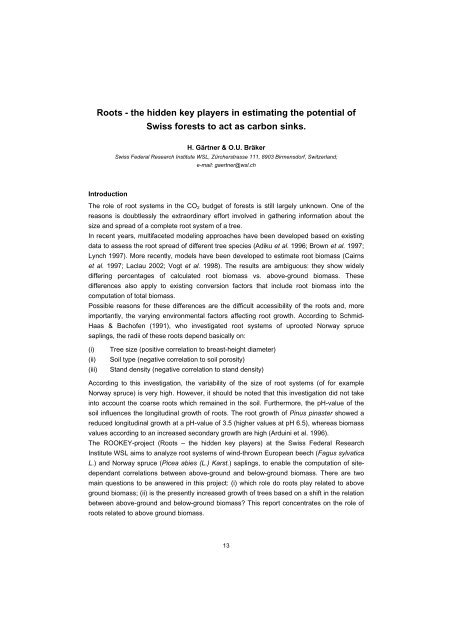TRACE Tree Rings Archaeology Climatology Ecology
E. Jansma et al. Umwelt Environment Umwelt Environment 44 ...
E. Jansma et al. Umwelt Environment Umwelt Environment 44 ...
- No tags were found...
Create successful ePaper yourself
Turn your PDF publications into a flip-book with our unique Google optimized e-Paper software.
Roots - the hidden key players in estimating the potential of<br />
Swiss forests to act as carbon sinks.<br />
H. Gärtner & O.U. Bräker<br />
Swiss Federal Research Institute WSL, Zürcherstrasse 111, 8903 Birmensdorf, Switzerland;<br />
e-mail: gaertner@wsl.ch<br />
Introduction<br />
The role of root systems in the CO 2 budget of forests is still largely unknown. One of the<br />
reasons is doubtlessly the extraordinary effort involved in gathering information about the<br />
size and spread of a complete root system of a tree.<br />
In recent years, multifaceted modeling approaches have been developed based on existing<br />
data to assess the root spread of different tree species (Adiku et al. 1996; Brown et al. 1997;<br />
Lynch 1997). More recently, models have been developed to estimate root biomass (Cairns<br />
et al. 1997; Laclau 2002; Vogt et al. 1998). The results are ambiguous: they show widely<br />
differing percentages of calculated root biomass vs. above-ground biomass. These<br />
differences also apply to existing conversion factors that include root biomass into the<br />
computation of total biomass.<br />
Possible reasons for these differences are the difficult accessibility of the roots and, more<br />
importantly, the varying environmental factors affecting root growth. According to Schmid-<br />
Haas & Bachofen (1991), who investigated root systems of uprooted Norway spruce<br />
saplings, the radii of these roots depend basically on:<br />
(i)<br />
(ii)<br />
(iii)<br />
<strong>Tree</strong> size (positive correlation to breast-height diameter)<br />
Soil type (negative correlation to soil porosity)<br />
Stand density (negative correlation to stand density)<br />
According to this investigation, the variability of the size of root systems (of for example<br />
Norway spruce) is very high. However, it should be noted that this investigation did not take<br />
into account the coarse roots which remained in the soil. Furthermore, the pH-value of the<br />
soil influences the longitudinal growth of roots. The root growth of Pinus pinaster showed a<br />
reduced longitudinal growth at a pH-value of 3.5 (higher values at pH 6.5), whereas biomass<br />
values according to an increased secondary growth are high (Arduini et al. 1996).<br />
The ROOKEY-project (Roots – the hidden key players) at the Swiss Federal Research<br />
Institute WSL aims to analyze root systems of wind-thrown European beech (Fagus sylvatica<br />
L.) and Norway spruce (Picea abies (L.) Karst.) saplings, to enable the computation of sitedependant<br />
correlations between above-ground and below-ground biomass. There are two<br />
main questions to be answered in this project: (i) which role do roots play related to above<br />
ground biomass; (ii) is the presently increased growth of trees based on a shift in the relation<br />
between above-ground and below-ground biomass? This report concentrates on the role of<br />
roots related to above ground biomass.<br />
13
















